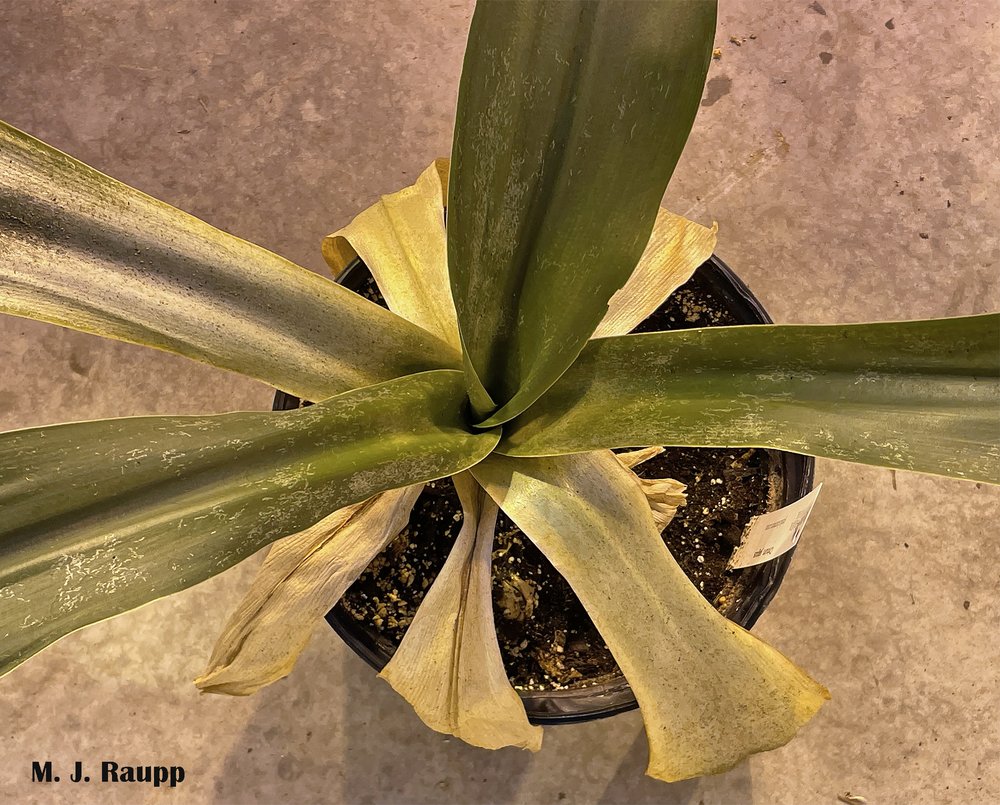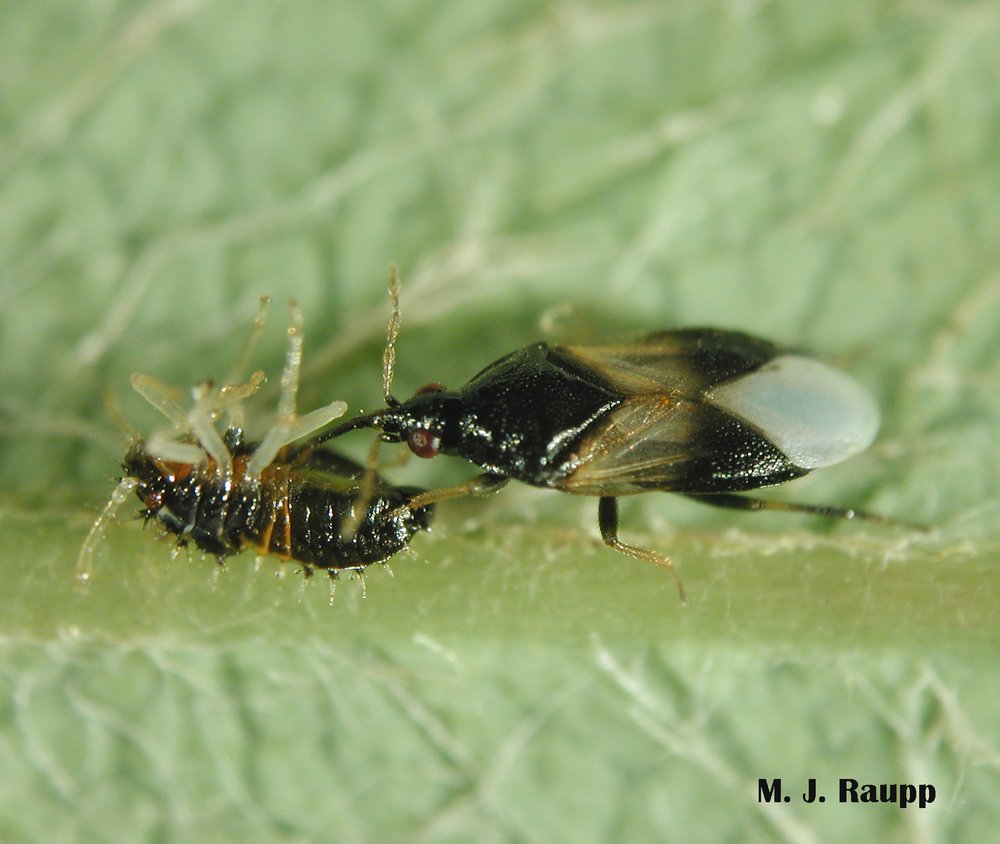From the mailbag – white lilies feeling the blues: Could it be the banded greenhouse thrips, Hercinothrips femoralis?

Herds of yellow thrips larvae and dark brown adult thrips turn green leaf tissue silver as they suck the life out of a white swamp lily. Spherical blobs of dark brown excrement are another clue of a thrips infestation.

This poor swamp lily is headed to the compost heap after being attacked by thrips.
Got a call a few weeks ago about white swamp lilies feeling the blues from a greenhouse grower. White swamp lilies, Crinum powellii album, are a spectacular member of the amaryllis clan known for their extremely fragrant white blossoms, which give them their common name. While it can be planted outdoors in plant hardiness zones 6 – 11, at the northern edge of its range freezing temperatures cause dieback of above ground foliage. The white swamp lilies in question here also suffered above ground dieback of foliage, but resided in a campus greenhouse where temperatures were a balmy 65 degrees Fahrenheit or so. Ruling out the possibility of cold intolerance, a justifiably frustrated grower wondered why the sickly yellow and brown leaf color and decline of the lilies was happening. At first glance, silvery streaks and discolored patches of morbid leaf tissue necessitated a closer look. A peek through the 20X hand lens revealed a horde of tiny thrips cavorting, feasting, and despoiling the plant. A tentative identification of the culprit suggested this was the banded greenhouse thrips, a pest found outdoors in pantropical regions and in greenhouses around the world where it dines on a wide variety of vegetables, fruits, and ornamental plants, including lilies.
Thrips are strange little insects with an unusual name that is both singular and plural. Ten of these creatures are thrips, but a single individual is also a thrips. In addition to a strange name, they have equally strange and formidable mouthparts. A dagger like jaw punctures epidermal and parenchyma cells of the leaf and another set of mouthparts slurp up nutritious cell contents. Thrips feeding causes discolored areas of leaf tissue and sometimes silver streaks on the surface of a leaf. The immature stages of thrips, called larvae, are translucent and often yellow or whitish in color. They cannot fly and molt several times before transforming into winged adults capable of flight. Depending on the species, adults can be yellow to dark brown in color, as is the case with the fiends on our swamp lilies. Their tiny wings, lined with featherlike hairs, are the source of their Latin name, Thysanoptera, which means “feather wing”.
This white swamp lily is really in the hurt locker with leaves yellowing and crumpling in a death wilt. Zooming in on a leaf, we see silver streaking and a row of tiny black adult thrips dining near a leaf vein. Herds of larval thrips, many wearing a black fecal droplet on their rear end, feed on leaf tissue. Watch the digestive tract of a thrips larva pulse and quiver as it imbibes liquids from a leaf. Nearby, an adult thrips seems more intent on grooming its antennae rather than dining on a leaf.
Female thrips can lay scores of eggs. Indoors where plants are warm and dry during winter months, thrips may complete multiple generations over the course of several weeks. In addition to damage caused as they feed, thrips leave behind little gifts in the form of black fecal deposits. These small treasures litter the surface of the leaf and collect on surfaces below the plant. A vigorous washing with a spray of water may dislodge some of the thrips and provide a modicum of relief. However, many species embed their eggs in the leaf tissue and these are unlikely to be dislodged by a spray. Many insecticides are available to kill thrips. One active ingredient that can be purchased by homeowners and professionals alike is spinosad. Derived from the soil inhabiting bacterium, Saccharopolyspora spinosa, spinosad is approved for use not only on greenhouse plants but also in the production of certified organic vegetables.

When not dining on lace bugs, minute pirate bugs like this one attack and kill thrips outdoors and also when released in thrips-infested greenhouses.
Ah, but a more natural and perhaps more entertaining way to manage them is to release hungry predators with a taste for thrips. Greenhouse growers manage these rascals by releasing predatory mites or minute pirate bugs that attack and eat thrips in a strategy called biological control. Another biological control tactic that has proven effective is to treat thrips with entomopathogenic (insect killing) nematodes. These tiny roundworms can be purchased and sprayed on the plant and underlying soil to kill developing thrips. The nematodes invade the body of the thrips and release a lethal bacterium. However, when plants are heavily infested with thrips, sometimes the best strategy is to say goodbye to the old ones, and “gift” yourself a new one.
Acknowledgements
We thank Sam Bahr for discovering the thrips featured in this episode and Juang Chong, Dan Gilrein, Felipe Soto-Adames, Matt Bertone, Mark Hoddle, Frank Hale, and Stanton Gill for helping with the identity of this rascal. The fact-filled fact sheet by Ronald F.L. Mau and Jayma L. Martin was used to prepare this story.
This post appeared first on Bug of the Week